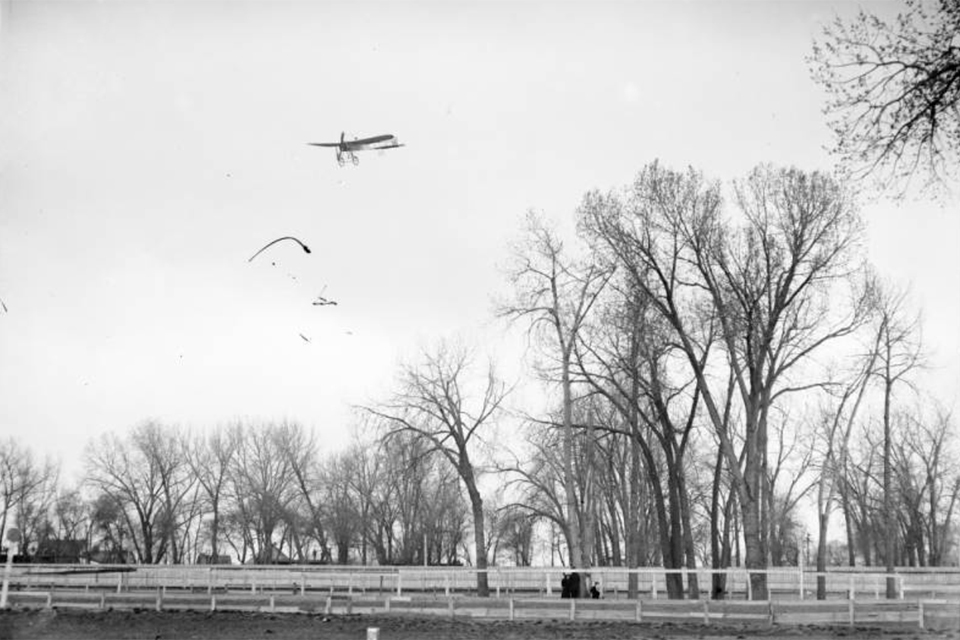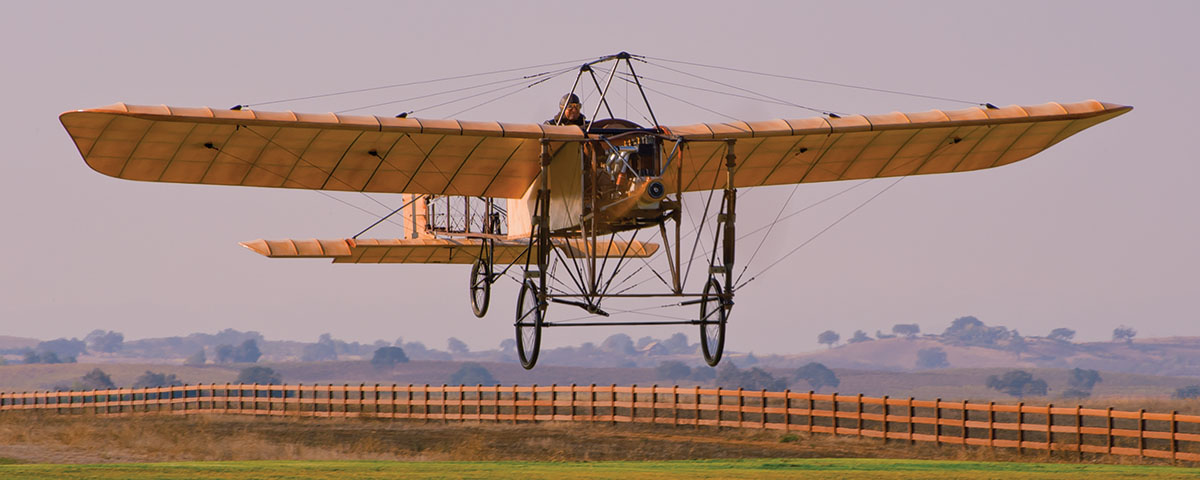Fabricated by teenage brothers in 1911, this unique homebuilt is once again airworthy.
Despite its shortcomings, the Blériot XI was one of the great designs of aviation’s early years. The successful fruit of numerous prior attempts—and failures—by French pioneer aviator Louis Blériot, it was tricky and even dangerous to fly, largely because its horizontal stabilizer had an airfoil like the wing, which could cause the nose to suddenly pitch down during high-speed dives. When Blériot piloted the shoulder-winged monoplane on a historic 23½-mile hop across the English Channel in July 1909, however, he won his design a worldwide stamp of approval beyond its inherent merits. From then on, aviators out to score more firsts in distance, speed, altitude or endurance, or simply out to experience the thrill of early flight for its own sake, wanted a Blériot XI. Besides the examples Blériot produced, a number of other companies on either side of the Atlantic manufactured it under license, while other budding fliers built their own planes based on its basic layout. It was in that last category that the VanDersarl brothers staked their modest claim to fame.
Little is now known about Jules “J.J.” VanDersarl and his younger brother, Frank, except that they lived just outside Denver, Colo.; their mother worked as a housekeeper; and they barely made it through grade school. But both brothers proved to have innate mechanical talents that made them proficient at machining, carpentry and other skills. Given that, it’s not surprising these young men, like a good many others at the time, became enthralled with aviation. J.J. experimented with gliders at age 12, and later, a few months after Blériot’s 1909 Channel flight, he and Frank got more ambitious. Obtaining all the publications and photographs they could, they used those references to build their own Blériot XI in 1911…then learned to fly it.
According to Javier Arango, director of The Aeroplane Collection in Paso Robles, Calif., who now owns the VanDersarl Blériot, the brothers “must have had some guidance and lots of information,” because the dimensions of their airplane are close to those of the original. Their homebuilt differs from the standard Blériot XI in three respects, however. First and foremost, instead of the 25-hp Anzani 3-cylinder radial or Gnome rotary engine that normally powered Blériots, the VanDersarls, using their general knowledge and machining skills, adapted a 4-cylinder inline air-cooled automobile engine with a reworked oil system to aerial use. Just what that engine was remains uncertain, though Arango said it was “close in dimensions” to the power plant used in the Metz, a car equipped with a liquid-cooled engine that the company had planned to adapt to aviation but which never quite materialized.
A second difference, Arango noted, was that “some of the structure around the empennage is placed slightly differently than in most Blériots.” Finally, he said, “The French Blériots were built to a high quality, but our plane was built by teen agers in Colorado who just wanted to go fly—it’s a little rougher than pristine Blériots.”
Even so, the handmade airplane worked remarkably well. “There is a photo of the first flight, which ended up in a landing that broke the landing gear,” Arango reported. “But it was repaired and flew again. Both brothers flew it.”

The VanDersarls went on to fly Curtiss JN-4 Jennys and Standards, and in the 1920s, Arango said, “Frank started an airport and barnstorming operation.” The most remarkable thing, though, is that Frank kept the homebuilt in which he and J.J. had first learned how to fly. “I’m so glad they kept it,” Arango remarked. “This breed of airplane is quite rare. The Smithsonian Institution has only one such aircraft.”
In the 1960s Frank VanDersarl tried to restore the Blériot, but he died before completing the project. After J.J. VanDersarl died in Raton, N.M., in November 1977, the monoplane was exhibited at the Museum of New Mexico. In 1994 it was bought by Joseph Gertler, who loaned it to Dowling College in Bayport, N.Y. There it was further restored by John Zale, Frankie Mineo, Russ Moore and the Bayport Aerodrome Society. Then in 2009 Arango’s C.C. Air Corporation purchased it and added it to The Aeroplane Collection, with the ultimate goal of making it airworthy for the first time in a century.
“When we got it the plane was minimally restored,” Arango explained. “It was extremely authentic.” That meant it served as a useful reference toward the inevitable replacement of deteriorated material and components. “Chuck Wentworth from Antique Aero, who is really the main character in the restoration project, inspected it and went through everything,” he said. “The entire fuselage was in good shape. There were busted wires and turnbuckles that had to be reproduced and replaced to get it back to original condition. Chuck had to find parts of 1911 vintage to get the correct look, based on plans and photos. For example, they’d stuck a fake control wheel in the cockpit for display. We took all of that out.
“The wings were difficult—they were not the same age as the fuselage. They were probably damaged and were repaired or rebuilt by the VanDersarls. It took a lot of work with the wings to make them airworthy. The cotton covering was difficult to work with, and we even had to find the ‘honey-colored coating’ the VanDersarls described. We used a varnish that was tinted to get the correct honey color.”
Though he considered obtaining an Anzani engine, Arango decided to heed the advice of the National Air and Space Museum and “keep it as it was” by reconstructing the original engine. Fortunately for the restoration team, the VanDersarls “left good data on the cylinders, the copper cooling fins—all the specifications we needed to build the engine from scratch. The engine was put together with help from period publications and photos of the original.” The most difficult part was getting period components, but they managed to obtain a 1905 Bosch magneto, a brass carburetor of 1909 vintage, a tachometer, a magneto switch and a 1910 automobile oil gauge. In 2011 Wentworth unveiled the Blériot at the National Aviation Heritage Invitational in Reno, Nev. There on September 18 it won the event’s top award, the RollsRoyce Aviation Heritage Trophy.
Once the four-year project was completed, Arango and his team went through a systematic process toward getting it approved for flight by the Federal Aviation Administration. This presented some challenges, Arango said, since the Blériot XI predated the Civil Aeronautics Administration, let alone the FAA, and “there is no certificate and no paperwork of the age to make it current.” After the FAA inspected the aircraft, however, it finally registered the VanDersarl Blériot as an experimental airplane on August 16, 2012. This meant it could be flown under certain restrictions, such as not carrying a passenger for hire and with limits on the number of flights and travel radius around the airfield. “That was fine by us,” said Arango, “because we were happy to just fly, more or less in a straight line.”
Even with FAA approval, the VanDersarl Blériot underwent testing, reinspection and taxiing trials before it finally got airborne for the first time in more than a century on November 3, 2012. Since then, Arango keeps its flight itinerary at Paso Robles under tight self-imposed restrictions. “It’s a marginal airplane,” he explained, “with a 50-hp engine and very cambered wings that cause a lot of drag. It’s a good-flying airplane, but I’m not going to risk the airframe. It’s one of a kind, touched twice by its creators, and once by Chuck. I wanted it authentic to its own type.”
Originally published in the March 2014 issue of Aviation History. To subscribe, click here.





